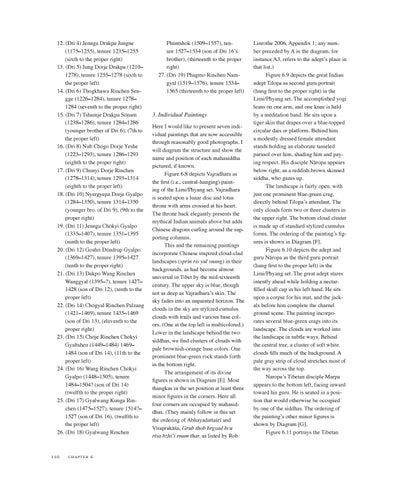12. (Dri 4) Jennga Drakpa Jungne (1175–1255), tenure 1235–1255 (sixth to the proper right) 13. (Dri 5) Jung Dorje Drakpa (1210– 1278), tenure 1255–1278 (sixth to the proper left) 14. (Dri 6) Thogkhawa Rinchen Sengge (1226–1284), tenure 1278– 1284 (seventh to the proper right) 15. (Dri 7) Tshamje Drakpa Sönam (1238–1286), tenure 1284–1286 (younger brother of Dri 6), (7th to the proper left) 16. (Dri 8) Nub Chögo Dorje Yeshe (1223–1293), tenure 1286–1293 (eighth to the proper right) 17. (Dri 9) Chunyi Dorje Rinchen (1278–1314), tenure 1293–1314 (eighth to the proper left) 18. (Dri 10) Nyergyepa Dorje Gyalpo (1284–1350), tenure 1314–1350 (younger bro. of Dri 9), (9th to the proper right) 19. (Dri 11) Jennga Chökyi Gyalpo (1335–1407), tenure 1351–1395 (ninth to the proper left) 20. (Dri 12) Goshri Döndrup Gyalpo (1369–1427), tenure 1395–1427 (tenth to the proper right) 21. (Dri 13) Dakpo Wang Rinchen Wanggyal (1395–?), tenure 1427– 1428 (son of Dri 12), (tenth to the proper left) 22. (Dri 14) Chögyal Rinchen Palzang (1421–1469), tenure 1435–1469 (son of Dri 13), (eleventh to the proper right) 23. (Dri 15) Chöje Rinchen Chökyi Gyaltshen (1449–1484) 1469– 1484 (son of Dri 14), (11th to the proper left) 24. (Dri 16) Wang Rinchen Chökyi Gyalpo (1448–1505), tenure 1484–1504? (son of Dri 14) (twelfth to the proper right) 25. (Dri 17) Gyalwang Kunga Rinchen (1475–1527), tenure 1514?– 1527 (son of Dri 16), (twelfth to the proper left) 26. (Dri 18) Gyalwang Rinchen
110
ch ap t e r 6
Phüntshok (1509–1557), tenure 1527–1534 (son of Dri 16’s brother), (thirteenth to the proper right) 27. (Dri 19) Phagmo Rinchen Namgyal (1519–1576), tenure 1534– 1565 (thirteenth to the proper left)
3. Individual Paintings Here I would like to present seven individual paintings that are now accessible through reasonably good photographs. I will diagram the structure and show the name and position of each mahasiddha pictured, if known. Figure 6.8 depicts Vajradhara as the first (i.e., central-hanging) painting of the Limi/Phyang set. Vajradhara is seated upon a lunar disc and lotus throne with arms crossed at his heart. The throne back elegantly presents the mythical Indian animals above but adds Chinese dragons curling around the supporting columns. This and the remaining paintings incorporate Chinese inspired cloud-clad landscapes (sprin ris yul snang) in their backgrounds, as had become almost universal in Tibet by the mid-sixteenth century. The upper sky is blue, though not as deep as Vajradhara’s skin. The sky fades into an unpainted horizon. The clouds in the sky are stylized cumulus clouds with trails and various base colors. (One at the top left is multicolored.) Lower in the landscape behind the two siddhas, we find clusters of clouds with pale brownish-orange base colors. One prominent blue-green rock stands forth in the bottom right. The arrangement of its divine figures is shown in Diagram [E]. Most thangkas in the set position at least three minor figures in the corners. Here all four corners are occupied by mahasiddhas. (They mainly follow in this set the ordering of Abhayadattaśrī and Viraprakāśa, Grub thob brgyad bcu rtsa bzhi’i rnam thar, as listed by Rob
Linrothe 2006, Appendix 1; any number preceded by A in the diagram, for instance A3, refers to the adept’s place in that list.) Figure 6.9 depicts the great Indian adept Tilopa as second guru portrait (hung first to the proper right) in the Limi/Phyang set. The accomplished yogi leans on one arm, and one knee is held by a meditation band. He sits upon a tiger skin that drapes over a blue-topped circular dais or platform. Behind him a modestly dressed female attendant stands holding an elaborate tasseled parasol over him, shading him and paying respect. His disciple Nāropa appears below right, as a reddish-brown skinned siddha, who gazes up. The landscape is fairly open, with just one prominent blue-green crag, directly behind Tilopa’s attendant. The only clouds form two or three clusters in the upper right. The bottom cloud cluster is made up of standard stylized cumulus forms. The ordering of the painting’s figures is shown in Diagram [F]. Figure 6.10 depicts the adept and guru Nāropa as the third guru portrait (hung first to the proper left) in the Limi/Phyang set. The great adept stares intently ahead while holding a nectarfilled skull cup in his left hand. He sits upon a corpse for his mat, and the jackals before him complete the charnel ground scene. The painting incorporates several blue-green crags into its landscape. The clouds are worked into the landscape in subtle ways. Behind the central tree, a cluster of soft white clouds fills much of the background. A pale gray strip of cloud stretches most of the way across the top. Naropa’s Tibetan disciple Marpa appears to the bottom left, facing inward toward his guru. He is seated in a position that would otherwise be occupied by one of the siddhas. The ordering of the painting’s other minor figures is shown by Diagram [G]. Figure 6.11 portrays the Tibetan
